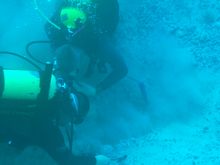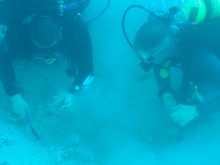Scuba Diving: Underwater Archaeology Face to Face
July 25, 2009
Jessi Halligan
Texas A&M University
![]() Watch scientists conduct remote-sensing activities using a side scan sonar system.
Watch scientists conduct remote-sensing activities using a side scan sonar system.
We are meeting our research goals this year through the use of two main methods of exploration: remote sensing and scuba diving. Remote sensing gives us indirect images of large areas of the ocean floor and the sediments immediately underneath the surface, while scuba diving allows us to directly observe very small portions of the seabed.
Scuba diving, as done for archaeology, is very different from recreational scuba; and diving for submerged prehistoric sites is different than typical archaeological diving. Traditional divers work to develop the skill of neutral buoyancy, avoiding the seafloor and ocean life, and striving to keep visibility as clear as possible. Many underwater archaeologists are focused on researching shipwrecks while others work on excavations in shallow freshwater rivers, lakes, and streams.
For this project, we are most interested in the information contained within the bottom sediments below the seafloor, as the surface sands have been constantly moved around by ocean currents and bioturbated (mixed up by living creatures). Sediments below these top layers, though, may be the remnants of Pleistocene shorelines, hills, valleys, and other landforms that were used by Paleoindians and then buried by the ocean throughout the Holocene.
We use our remote-sensing images to tell us where these buried layers may have survived sea level rise, picking the best “targets” for diver inspection in areas as shallow as 9 meters (30 feet) or as deep as 40 m (130 ft). We dive straight to the seabed, digging through the surface sands by a technique known as hand-fanning, to look for artifacts, bones, and/or sediments of terrestrial (land) rather than marine origins. We also take 1-m-long (3-ft-long) cores everywhere possible so we can see what is deeper underground than we can easily hand-fan.
This means we spend a lot of time close to the ground, stirring up vast amounts of dirt and completely obscuring visibility in the water column. Through practice, we become very good at knowing what we are seeing by feel alone, and we have to learn to be very efficient, as the amount of time we can safely spend underwater is directly related to how deep we dive. At 40 m/130 ft we can dive for only 12 minutes without risking decompression sickness, while at 9 m/30 ft we can spend as much time underwater as we want.
To make this effort a success, three archaeologists (Dr. C. Andrew Hemming, Cliff Brown, and myself) and a NOAA scientist, Dr. Nicolas Alvarado, work together as a team on every dive to gain as much subsurface data as possible, including biological specimens, sediment samples, video, and photographs.
The diving thus ground truths (confirms by field check) the information our remote sensing is giving us, and allows us to gain a fuller understanding of both the modern and ancient Gulf of Mexico.
Sign up for the Ocean Explorer E-mail Update List.

















